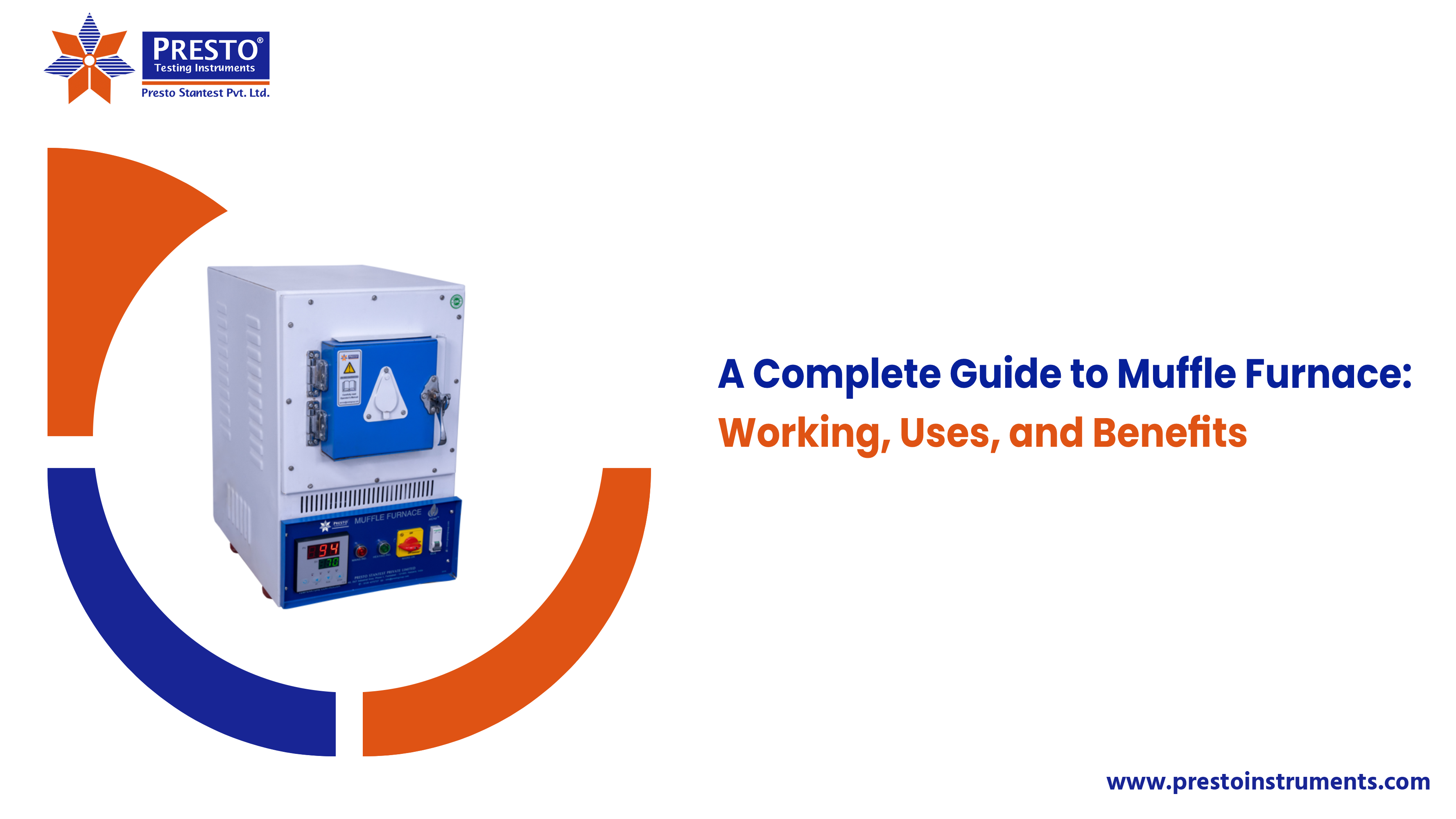
05-Nov-2025
Presto Instruments
A muffle furnace is an essential laboratory testing equipment that allows for heating applications that are high-temperature and primarily used for material testing, ash determinations, and heat treatments. A muffle furnace is used for its consistent and accurate temperature controls and uniform heating throughout all applications.
It produces reliable results in the laboratory, whether in ceramics, biology, agriculture, or manufacturing. Presto Instruments is a leading manufacturer of testing and inspection equipment. They also specialize in a variety of muffle furnaces, providing superior accuracy, safety, and efficiency for a variety of industrial applications.
A muffle furnace is a laboratory device that heats materials to exceptionally high temperatures without exposing them directly to the fuel and combustion by-products at the heat source. Muffle furnaces allow for the isolation of the material to reduce the risks of cross-contamination and identify specific properties.
It comprises a heating element, an insulated chamber, and a temperature control system. The furnace finds extensive applications in laboratories for material analysis and quality control, including thermal processing.
A muffle furnace is composed of an outer casing, insulation, heating elements, the muffle chamber, a control panel, and sometimes even an exhaust system. The insulation and heating elements are situated around the chamber and provide indirect heating to samples while maintaining a very stable, isolated temperature.
Here are the major components of a muffle furnace:
A muffle furnace operates on the principle of indirect heating. The heating elements present outside the inner chamber, the “muffle,” are used in producing heat, which is transferred to a sample inside by radiation and convection.
The working procedure of the muffle furnace involves the indirect heating of a sample inside a shielded chamber by turning the heating elements on.
Here are the steps explained in detail:
A muffle furnace is mainly used for intense heating in a controlled, safe, and clean environment. The top five uses it has found across industries and research fields include:
One of the principal applications is to measure the ash (inorganic) content of diverse organic and some inorganic materials such as coal, foodstuffs, rubber and plastics. The furnace incinerates all organic material, leaving only the non-combustible material (ash) for quality control and gravimetric analysis.
Muffle furnaces are widely used in metallurgy for changing the physical and chemical properties of metals and alloys. The processes involved in heat treating metals and alloys are:
In the ceramics and glassmaking industries, muffle kilns offer the highest quality and uniform temperatures needed for sintering powdered raw materials into strong, durable solid structures and firing or annealing glass products to improve quality and durability.
Researchers have the capacity to assess the thermal characteristics, longevity, and makeup of a multitude of materials - including advanced ceramics, composites, or nanomaterials - in muffle furnaces, as well as prepare the samples for supplementary analysis (e.g., XRF analysis) and other analyses, with proper provisions for conducting the experiments at elevated temperatures and with suitable controls.
Muffle furnaces are used in different processes, including calcination (which is thermal decomposition), drying, and thermal decomposition of substances (both chemical and pharmaceutical). Within the pharmaceutical industry, such furnaces are utilized in drug stability tests when extreme temperatures are involved and when biological samples are incinerated.
The major benefits of muffle furnaces include temperature control accuracy, energy efficiency owing to insulation, high-temperature capability, and longevity in service.
The muffle furnaces are designed with digital temperature controllers and thermocouples for precise temperature regulation when heating material. The level of accuracy provided allows results to be both reproducible and dependable, thereby minimizing errors associated with material testing and heat treatment. It allows the user to maintain the exact thermal conditions needed for a range of laboratory and industrial applications.
The muffle furnace has strong heat resistance, which stops heat loss and improves energy use. With the insulated chamber, the muffle furnace can hold more heat and can therefore decrease power and production costs. This will lead to stable temperature performance-even in an extended continuous operation-and will be both environmentally friendly and economical for laboratories and production facilities.
Muffle furnaces can go up to very high temperatures—ordinarily between 900°C to 1200°C or higher—and are thus ideal for such applications. The safety of operating at an elevated temperature provides the necessary versatility needed in different sets of testing requirements for the determination of material strength, analysis of heat resistance, and purification of samples in various fields.
Because these furnaces were designed for durable materials and heating elements, the overall construction of muffle furnaces specifies the materials for long hours of service and little maintenance. Corrosion-resistant construction and insulation are efficient in reducing wear and tear.
Long-term operational reliability and performance make them a remarkable investment for laboratories and industrial test settings, with strategically designed cost and time efficiencies over the lifespan of the muffle furnace.
A muffle furnace is a trustworthy and essential appliance in the laboratory for running high-temperature applications both accurately and safely. Presto Instruments renders high-quality muffle furnaces, designed to meet modern industrial and laboratory standards. Whether for material testing or heat treatment, Presto’s muffle furnaces are designed to give accuracy in performance, durability, and efficiency for all your testing concerns.
Elevate your quality assurance process to new heights
At Presto, we take pride in being Global manufacturers of Laboratory Testing Instruments for different industries.